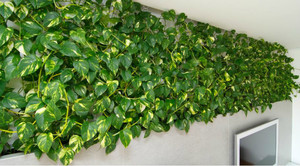 You can revive the shady corners of the apartment, decorate the walls or simply plant the greenery with the help of various climbing plants. They can be flowering and decorative-deciduous, miniature and impressive in size. Many of them grow quickly, look beautiful in the interior, and do not require special care and growing conditions. This article presents photos, names and descriptions of the most beautiful and unpretentious indoor climbing plants.
You can revive the shady corners of the apartment, decorate the walls or simply plant the greenery with the help of various climbing plants. They can be flowering and decorative-deciduous, miniature and impressive in size. Many of them grow quickly, look beautiful in the interior, and do not require special care and growing conditions. This article presents photos, names and descriptions of the most beautiful and unpretentious indoor climbing plants.
Content
Decorative deciduous vines
Indoor curly flowers differ in the shape and color of the leaves, often this is what their names are based on. Plants can be dark green, as in the photo, and light purple, variegated and monochromatic, pointed, oval or carved.
 Cissus or birch... Quite common unpretentious plant is a close relative of the vine. Its rich green leaves can have silvery blotches and be pink on the inside. Long shoots with the help of whiskers cling to the ledges, braiding the supports. With proper care in indoor conditions, a houseplant grows very quickly and pleases with its splendor.
Cissus or birch... Quite common unpretentious plant is a close relative of the vine. Its rich green leaves can have silvery blotches and be pink on the inside. Long shoots with the help of whiskers cling to the ledges, braiding the supports. With proper care in indoor conditions, a houseplant grows very quickly and pleases with its splendor.
Growing conditions:
- Cissus prefers good lighting, but can grow in shade too.
- Resistant to heat and tolerates cold easily.
- Does not like abundant soil moisture and responds well to spraying.
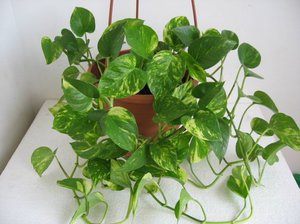 Scindapsus... Indoor climbing plant, which does not require much time and effort to grow. It can grow in almost any conditions. The flower can be hung by the window or placed in the farthest corner of the room. Its bright green leaves are distinguished by light spots and a heart shape. The home vine grows quickly, releasing new shoots that can simply hang down or entangle a support. To get a plant with lush shoots, it is recommended to pinch it periodically.
Scindapsus... Indoor climbing plant, which does not require much time and effort to grow. It can grow in almost any conditions. The flower can be hung by the window or placed in the farthest corner of the room. Its bright green leaves are distinguished by light spots and a heart shape. The home vine grows quickly, releasing new shoots that can simply hang down or entangle a support. To get a plant with lush shoots, it is recommended to pinch it periodically.
Growing features:
- In the first year at home, the flower grows slowly, but then grows quickly.
- During the period of active growth, it feels good at room temperature, and in winter it is recommended to keep the liana in a cool room.
- Fertilizers for feeding scindapsus are diluted twice weaker than indicated in the instructions on the package.
 Ivy... A curly flower with beautifully shaped leaves, clinging to supports, can quickly decorate bare surfaces and green windows. The color of the leaves of the creeper can be either monochromatic or variegated. Breeders have developed varieties of indoor ivy with leaves of unusual color and shape. Most of the plants have three- or five-lobed leathery, shiny leaves. Some varieties are distinguished by pointed, star-shaped, oval leaf plates. Ivy is a very unpretentious plant, therefore it does not require special care:
Ivy... A curly flower with beautifully shaped leaves, clinging to supports, can quickly decorate bare surfaces and green windows. The color of the leaves of the creeper can be either monochromatic or variegated. Breeders have developed varieties of indoor ivy with leaves of unusual color and shape. Most of the plants have three- or five-lobed leathery, shiny leaves. Some varieties are distinguished by pointed, star-shaped, oval leaf plates. Ivy is a very unpretentious plant, therefore it does not require special care:
- During active growth, it requires abundant watering.
- In spring and summer every two weeks it is fed with fertilizers for decorative deciduous plants.
- It grows especially well in bright diffused light, but also tolerates partial shading.
Decorative foliage curly flowers with large leaves
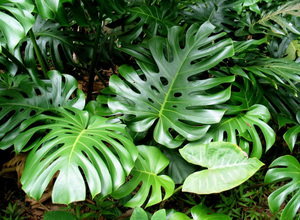 Monstera... A very spectacular and popular plant is distinguished by glossy, large, dark green leaves, which have cuts almost to the midrib along the edges, which is very clearly visible in the photo. Young plants have whole, heart-shaped leaves. The liana rises along the support with the help of thick, airy roots formed on the stem. At home, it can grow up to three meters.
Monstera... A very spectacular and popular plant is distinguished by glossy, large, dark green leaves, which have cuts almost to the midrib along the edges, which is very clearly visible in the photo. Young plants have whole, heart-shaped leaves. The liana rises along the support with the help of thick, airy roots formed on the stem. At home, it can grow up to three meters.
Care features:
- The aerial roots located at the bottom of the stem can be immersed in the soil, which will provide the plant with additional feeding.
- An ideal support for a monstera will be a tube wrapped in moss. In order for air roots to grow in it, the moss must be kept moist.
- Loves good lighting without direct sunlight.
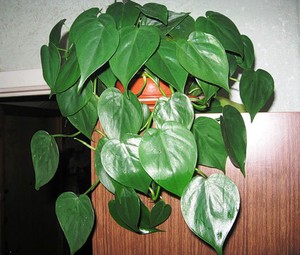 Philodendron climbing... The houseplant is distinguished by bright green glossy heart-shaped leaves. Their length can be from 10 cm or more. The leaves of a houseplant are alternately arranged on thin, creeping stems. To give the flower bushiness, its tops are pinched, and the shoots are tied to a support. Some species of vines look like scindapsus, but there are no light stripes on their leaves, and young leaf plates have a reddish underside.
Philodendron climbing... The houseplant is distinguished by bright green glossy heart-shaped leaves. Their length can be from 10 cm or more. The leaves of a houseplant are alternately arranged on thin, creeping stems. To give the flower bushiness, its tops are pinched, and the shoots are tied to a support. Some species of vines look like scindapsus, but there are no light stripes on their leaves, and young leaf plates have a reddish underside.
Care features:
- At home, the plant is grown in a well-lit place without direct sunlight.
- The substrate must always be kept moist. In winter, its surface should dry out.
- During the growth period, it is fed with complex fertilizers for lianas.
 Syngonium... Indoor vine at a young age is distinguished by bright, variegated arrow-shaped leaves, which become lobed with age. Aerial roots appear on the stems of the flower, which will be a good support for a moss stick. The syngonium has several varieties. Among them are vines with completely green and white leaves, as well as variegated plants. At home, it can grow up to one and a half meters.
Syngonium... Indoor vine at a young age is distinguished by bright, variegated arrow-shaped leaves, which become lobed with age. Aerial roots appear on the stems of the flower, which will be a good support for a moss stick. The syngonium has several varieties. Among them are vines with completely green and white leaves, as well as variegated plants. At home, it can grow up to one and a half meters.
Growing features:
- Variegated species like well-lit places without direct sunlight.
- Requires regular watering, between which the topsoil must dry out.
- In dry conditions, the leaves of syngonium begin to dry out, so the plant must be sprayed daily.
Flowering climbing plants
Through blooming lianas you can create a cozy atmosphere and a picturesque view in the house. They are used to decorate window sills, bookcases and shelves.
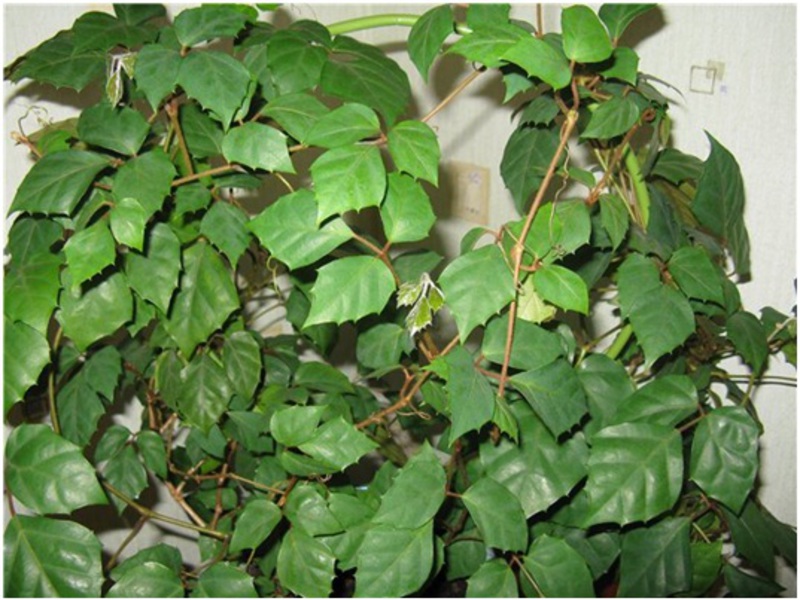
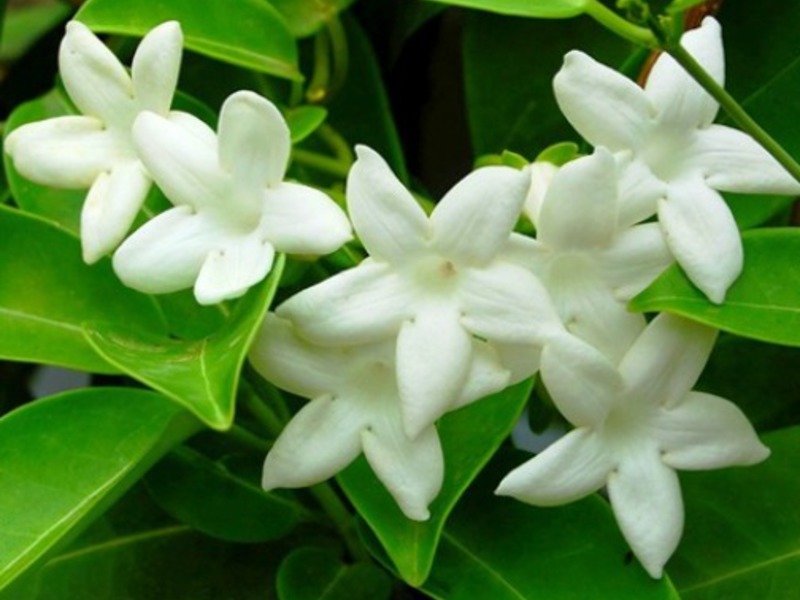



Unpretentious flowering vines
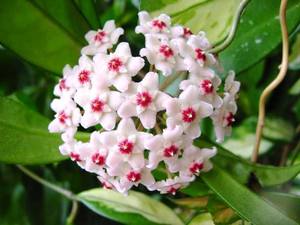 Hoya or wax ivy... Indoor vine, as the name implies, is a large climbing plant with beautiful leathery leaves, which is distinguished by star-shaped flowers (photo). At home, it can grow up to 3 meters in length. Flowering that begins in a favorable period can last for several months. At this time, the plant is not recommended to be rearranged from place to place and turned. It may stop blooming and shed the buds.
Hoya or wax ivy... Indoor vine, as the name implies, is a large climbing plant with beautiful leathery leaves, which is distinguished by star-shaped flowers (photo). At home, it can grow up to 3 meters in length. Flowering that begins in a favorable period can last for several months. At this time, the plant is not recommended to be rearranged from place to place and turned. It may stop blooming and shed the buds.
Growing features:
- On the windowsills of the east and west windows near wax ivy, elastic leaves of a bright color will grow.
- During active growth, watering is plentiful, in winter moderate.
- In the spring and summer, fertilizing with fertilizers with a high phosphorus content is required twice a month.
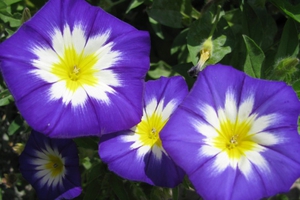 Ipomoea tricolor... Liana can be grown as a perennial plant in the home, and as an annual in the garden. It is distinguished by numerous green leaves and beautiful blue phonograph flowers, very recognizable, which is also clearly visible in the attached photo. They are evenly spaced on a thin stem, which must be tied to a trellis or other support. Dry buds are removed regularly to prolong flowering.
Ipomoea tricolor... Liana can be grown as a perennial plant in the home, and as an annual in the garden. It is distinguished by numerous green leaves and beautiful blue phonograph flowers, very recognizable, which is also clearly visible in the attached photo. They are evenly spaced on a thin stem, which must be tied to a trellis or other support. Dry buds are removed regularly to prolong flowering.
Growing features:
- It is recommended to grow indoor morning glory in a well-lit place, shading from direct sunlight.
- Needs abundant, regular watering. In no case should the soil dry out.
- In winter, the climbing plant must be kept in a cool room.
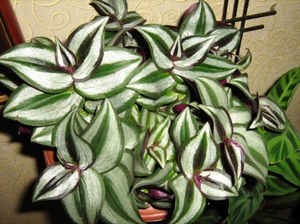 Tradescantia... One of the most popular climbing plants that can be found in almost every home. Liana at first glance can be recognized by pubescent, soft leaves of a silvery shade and short-lived white flowers. An exception is the tradescantia silomantana, which has purple leaves and flowers.
Tradescantia... One of the most popular climbing plants that can be found in almost every home. Liana at first glance can be recognized by pubescent, soft leaves of a silvery shade and short-lived white flowers. An exception is the tradescantia silomantana, which has purple leaves and flowers.
Growing conditions:
- It can grow in any well-lit place.
- From spring to autumn, it loves abundant watering, but excessive soil moisture can lead to rotting of the trunk and leaves.
- When feeding a plant, keep in mind that excess nitrogen will weaken the leaves.
Blooming lianas requiring special care
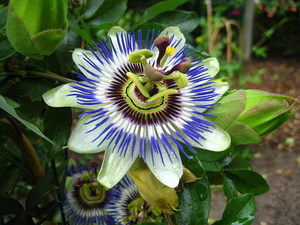 Passionflower... Evergreen vines as ampel decoration are grown to decorate a house, a loggia, a balcony. Its flowers are unusual and very beautiful (see the photo). They are distinguished by a brightly colored double perianth, cruciform stigmas and bright curved or straight filaments. At home, they grow blue and three-lane passionflower. The first is a liana with deeply dissected leaves and single flowers up to 10 cm in diameter. On the dark leaves of trefoil passionflower, grayish-purple stripes run along the main veins. Its yellowish-white flowers reach 4 cm in diameter.
Passionflower... Evergreen vines as ampel decoration are grown to decorate a house, a loggia, a balcony. Its flowers are unusual and very beautiful (see the photo). They are distinguished by a brightly colored double perianth, cruciform stigmas and bright curved or straight filaments. At home, they grow blue and three-lane passionflower. The first is a liana with deeply dissected leaves and single flowers up to 10 cm in diameter. On the dark leaves of trefoil passionflower, grayish-purple stripes run along the main veins. Its yellowish-white flowers reach 4 cm in diameter.
Basic growing conditions:
- Passionflower loves bright sunlight, so it grows well on southern windowsills.
- The air in the room must be sufficiently humid.
- In summer, it is recommended to take the climbing plant out to the balcony or garden.
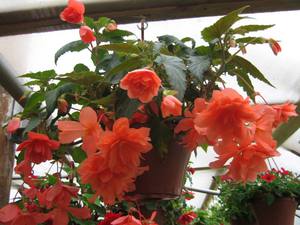 Ampel begonia... Hybrids of this indoor liana can bloom with simple or double pink, white, red flowers. The plant blooms in spring and blooms until autumn. In order for a curly flower to look beautiful and bloom for a long time, it needs to create certain conditions in the house:
Ampel begonia... Hybrids of this indoor liana can bloom with simple or double pink, white, red flowers. The plant blooms in spring and blooms until autumn. In order for a curly flower to look beautiful and bloom for a long time, it needs to create certain conditions in the house:
- Begonia must be placed in a well-lit place with diffused light.
- It is not recommended to dry or fill the plant. Watering is done immediately after the topsoil dries out.
- The temperature in the room where begonia grows should not fall below 15C.
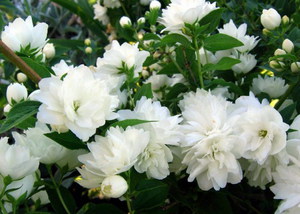 Jasmine... An indoor plant with fragrant flowers is loved by many growers. On its flexible shoots, leathery, dark green, pinnate leaves grow. Each leaf plate consists of seven small leaflets. Growing jasmine at home, the shoots are directed around the strings and supports. The tubular jasmine flowers of six petals bloom in mid-winter and bloom until the end of March. They are located one by one or in brushes at the ends of the shoots. Pure white flowers emerge from buds with pink bloom. For a year, a liana up to two meters high can grow from a young plant.
Jasmine... An indoor plant with fragrant flowers is loved by many growers. On its flexible shoots, leathery, dark green, pinnate leaves grow. Each leaf plate consists of seven small leaflets. Growing jasmine at home, the shoots are directed around the strings and supports. The tubular jasmine flowers of six petals bloom in mid-winter and bloom until the end of March. They are located one by one or in brushes at the ends of the shoots. Pure white flowers emerge from buds with pink bloom. For a year, a liana up to two meters high can grow from a young plant.
Care features:
- Jasmine prefers good lighting, so it can grow on southern windowsills. In summer, it must be shaded from the midday sun.
- During the budding period, the temperature in the room where the vine grows should be within 15C. At higher temperatures, the plant may not flower.
- A curly flower needs abundant watering. The soil in the pot should not dry out, otherwise the buds and leaves will begin to dry out and fall off.
With a little imagination, you can create a beautiful green corner from climbing plants in the house, among the foliage and flowers of which it will be pleasant to relax after a hard day's work.
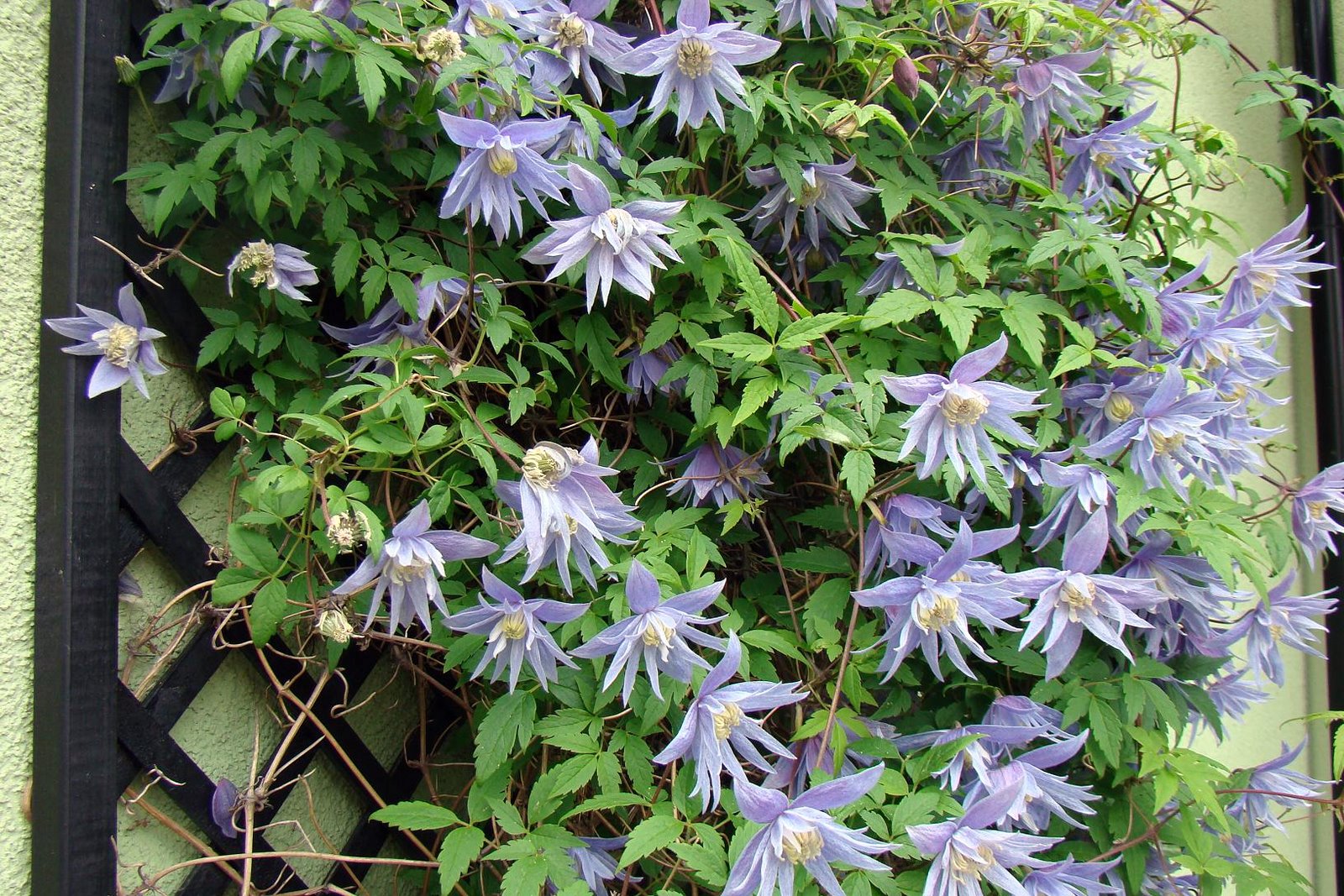


4 comments